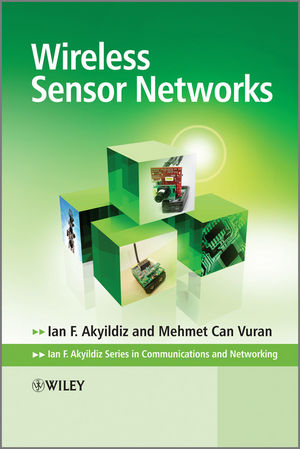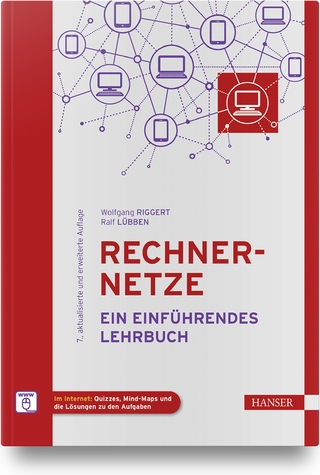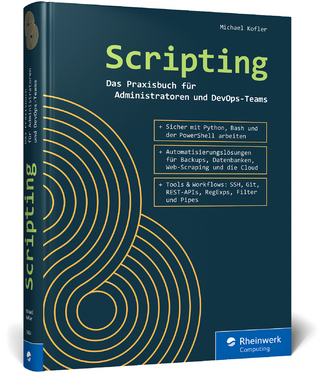
Wireless Sensor Networks
John Wiley & Sons Inc (Verlag)
978-0-470-03601-3 (ISBN)
This book presents an in-depth study on the recent advances in Wireless Sensor Networks (WSNs). The authors describe the existing WSN applications and discuss the research efforts being undertaken in this field. Theoretical analysis and factors influencing protocol design are also highlighted. The authors explore state-of-the-art protocols for WSN protocol stack in transport, routing, data link, and physical layers. Moreover, the synchronization and localization problems in WSNs are investigated along with existing solutions. Furthermore, cross-layer solutions are described. Finally, developing areas of WSNs including sensor-actor networks, multimedia sensor networks, and WSN applications in underwater and underground environments are explored. The book is written in an accessible, textbook style, and includes problems and solutions to assist learning.
Key Features:
The ultimate guide to recent advances and research into WSNs
Discusses the most important problems and issues that arise when programming and designing WSN systems
Shows why the unique features of WSNs – self-organization, cooperation, correlation -- will enable new applications that will provide the end user with intelligence and a better understanding of the environment
Provides an overview of the existing evaluation approaches for WSNs including physical testbeds and software simulation environments
Includes examples and learning exercises with a solutions manual; supplemented by an accompanying website containing PPT-slides.
Wireless Sensor Networks is an essential textbook for advanced students on courses in wireless communications, networking and computer science. It will also be of interest to researchers, system and chip designers, network planners, technical mangers and other professionals in these fields.
Dr. Ian F. Akyildiz is Ken Byers Distinguished Chair Professor in Telecommunications at the School of Electrical and Computer Engineering, Georgia Institute of Technology, and Director of the Broadband and Wireless Networking Laboratory. Current research interests are Sensor Networks, InterPlanetary Internet, Wireless Networks, Satellite Networks and Next Generation Internet. ?Ian has published over 200 journal and conference papers, is Editor-in-Chief of the Computer Networks and Ad Hoc Networks Journals (Elsevier), and an Editor for the ACM-Kluwer Journal of Wireless Networks. Ian is an IEEE Fellow (1996) with the citation: "For contributions to performance analysis of computer communication networks," and an ACM Fellow (1997) "for fundamental research contributions in: finite capacity queuing network models; performance evaluation of Time Warp parallel simulations; traffic Control in ATM networks, and mobility management in wireless networks". M. Can Vuran received his B.Sc. degree in electrical and electronics engineering from Bilkent University, Ankara, Turkey, in 2002. He received his M.S. degree in electrical and computer engineering from the School of Electrical and Computer Engineering, Georgia Institute of Technology, Atlanta, GA, in 2004. He is currently a Research Assistant in the Broadband and Wireless Networking Laboratory and pursuing his Ph.D. degree at the School of Electrical and Computer Engineering, Georgia Institute of Technology. His current research interests include cross-layer communication protocols for heterogeneous wireless architectures, wireless sensor networks, next generation wireless networks and deep space communication networks.
About the Series Editor xvii
Preface xix
1 Introduction 1
1.1 Sensor Mote Platforms 2
1.2 WSN Architecture and Protocol Stack 10
References 15
2 WSN Applications 17
2.1 Military Applications 17
2.2 Environmental Applications 21
2.3 Health Applications 26
2.4 Home Applications 29
2.5 Industrial Applications 31
References 33
3 Factors Influencing WSN Design 37
3.1 Hardware Constraints 37
3.2 Fault Tolerance 39
3.3 Scalability 40
3.4 Production Costs 40
3.5 WSN Topology 40
3.6 Transmission Media 41
3.7 Power Consumption 43
References 49
4 Physical Layer 53
4.1 Physical Layer Technologies 53
4.2 Overview of RF Wireless Communication 57
4.3 Channel Coding (Error Control Coding) 59
4.4 Modulation 62
4.5 Wireless Channel Effects 66
4.6 PHY Layer Standards 72
References 75
5 Medium Access Control 77
5.1 Challenges for MAC 77
5.2 CSMA Mechanism 80
5.3 Contention-Based Medium Access 83
5.4 Reservation-Based Medium Access 103
5.5 Hybrid Medium Access 110
References 115
6 Error Control 117
6.1 Classification of Error Control Schemes 117
6.2 Error Control in WSNs 120
6.3 Cross-layer Analysis Model 123
6.4 Comparison of Error Control Schemes 131
References 137
7 Network Layer 139
7.1 Challenges for Routing 139
7.2 Data-centric and Flat-Architecture Protocols 141
7.3 Hierarchical Protocols 148
7.4 Geographical Routing Protocols 152
7.5 QoS-Based Protocols 159
References 163
8 Transport Layer 167
8.1 Challenges for Transport Layer 167
8.2 Reliable Multi-Segment Transport (RMST) Protocol 169
8.3 Pump Slowly, Fetch Quickly (PSFQ) Protocol 171
8.4 Congestion Detection and Avoidance (CODA) Protocol 175
8.5 Event-to-Sink Reliable Transport (ESRT) Protocol 177
8.6 GARUDA 180
8.7 Real-Time and Reliable Transport (RT)2 Protocol 185
References 189
9 Application Layer 191
9.1 Source Coding (Data Compression) 191
9.2 Query Processing 195
9.3 Network Management 212
References 218
10 Cross-layer Solutions 221
10.1 Interlayer Effects 222
10.2 Cross-layer Interactions 224
10.3 Cross-layer Module 229
References 240
11 Time Synchronization 243
11.1 Challenges for Time Synchronization 243
11.2 Network Time Protocol 245
11.3 Definitions 246
11.4 Timing-Sync Protocol for Sensor Networks (TPSN) 248
11.5 Reference-Broadcast Synchronization (RBS) 251
11.6 Adaptive Clock Synchronization (ACS) 253
11.7 Time Diffusion Synchronization Protocol (TDP) 254
11.8 Rate-Based Diffusion Protocol (RDP) 257
11.9 Tiny- and Mini-Sync Protocols 258
11.10 Other Protocols 260
References 262
12 Localization 265
12.1 Challenges in Localization 265
12.2 Ranging Techniques 268
12.3 Range-Based Localization Protocols 272
12.4 Range-Free Localization Protocols 280
References 284
13 Topology Management 287
13.1 Deployment 288
13.2 Power Control 289
13.3 Activity Scheduling 296
13.4 Clustering 308
References 317
14 Wireless Sensor and Actor Networks 319
14.1 Characteristics of WSANs 321
14.2 Sensor–Actor Coordination 325
14.3 Actor–Actor Coordination 337
14.4 WSAN Protocol Stack 345
References 348
15 Wireless Multimedia Sensor Networks 349
15.1 Design Challenges 350
15.2 Network Architecture 353
15.3 Multimedia Sensor Hardware 357
15.4 Physical Layer 365
15.5 MAC Layer 367
15.6 Error Control 371
15.7 Network Layer 374
15.8 Transport Layer 379
15.9 Application Layer 383
15.10 Cross-layer Design 388
15.11 Further Research Issues 392
References 394
16 Wireless Underwater Sensor Networks 399
16.1 Design Challenges 401
16.2 Underwater Sensor Network Components 402
16.3 Communication Architecture 405
16.4 Basics of Underwater Acoustic Propagation 409
16.5 Physical Layer 414
16.6 MAC Layer 416
16.7 Network Layer 426
16.8 Transport Layer 435
16.9 Application Layer 437
16.10 Cross-layer Design 437
References 440
17 Wireless Underground Sensor Networks 443
17.1 Applications 445
17.2 Design Challenges 447
17.3 Network Architecture 450
17.4 Underground Wireless Channel for EM Waves 453
17.5 Underground Wireless Channel for Magnetic Induction 463
17.6 Wireless Communication in Mines and Road/Subway Tunnels 466
17.7 Communication Architecture 474
References 480
18 Grand Challenges 483
18.1 Integration of Sensor Networks and the Internet 483
18.2 Real-Time and Multimedia Communication 484
18.3 Protocol Stack 485
18.4 Synchronization and Localization 485
18.5 WSNs in Challenging Environments 486
18.6 Practical Considerations 488
18.7 Wireless Nano-sensor Networks 488
References 489
Index 491
| Erscheint lt. Verlag | 19.8.2010 |
|---|---|
| Reihe/Serie | Advanced Texts in Communications and Networking |
| Verlagsort | New York |
| Sprache | englisch |
| Maße | 176 x 251 mm |
| Gewicht | 1021 g |
| Themenwelt | Mathematik / Informatik ► Informatik ► Netzwerke |
| Technik ► Elektrotechnik / Energietechnik | |
| Technik ► Nachrichtentechnik | |
| ISBN-10 | 0-470-03601-X / 047003601X |
| ISBN-13 | 978-0-470-03601-3 / 9780470036013 |
| Zustand | Neuware |
| Haben Sie eine Frage zum Produkt? |
aus dem Bereich


